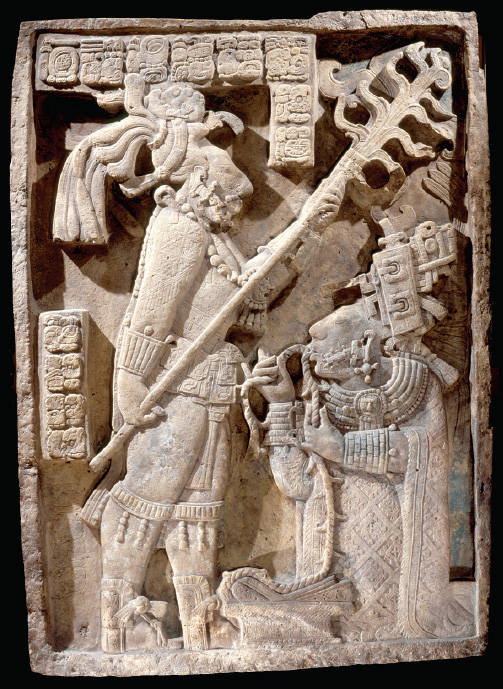Visual Source 6.3: A Bloodletting Ritual
The bleeding and ultimately the sacrifice of the captives in Visual Source 6.2 was part of a more pervasive practice of bloodletting that permeated Maya religious and court life. Significant occasions—such as birth, marriage, death, planting crops, and dedicating buildings—were sanctified with human blood, the most valued and holy substance in the world. Behind this practice lay the Maya belief in the mutual relationship of humans and their gods. Two of the major scholars in this field explain: “The earth and its creatures were created through a sacrificial act of the gods, and human beings, in turn, were required to strengthen and nourish the gods.”31 The means of doing so was blood. The massive loss of blood often triggered a trancelike state that the Maya experienced as mystical union with their gods or ancestors. The lancets used to draw blood—usually from the tongue in women and often from the penis in men—were invested with sacred power.
Kings and their wives were central to this bloodletting ritual, as Visual Source 6.3 so vividly shows. Here we meet again Shield Jaguar and Lady Xok, depicted also in Visual Source 6.1. The date of this carving is October 28, 709 C.E. The king is holding a large torch, suggesting that the ritual occurs at night, while his kneeling wife draws a thorn-studded rope through her perforated tongue. The rope falls into a basket of bloody paper, which will be burned with the resulting smoke nourishing the gods. Shield Jaguar too will soon let his own blood flow, for the glyphs accompanying this carving declare that “he is letting blood” and “she is letting blood.”

Question
GZwo6Nc6IqLNEHgX/NTfC/LuMiwuw9CBRz4M9lQXlcaMCjapl2QM90jUZ/+jR153KgNaeETFUuzQ8cYJgDwTyNDOXlrrk2N3X49DOA==Question
DcSwHmopk7GTxRfEiqC6PQtAmdGpojwAKGkYS0Ii5QkWVQ3kavWVbpVWy1LPu08gQvvMUhyRDxACyZg5unAbWnpGYBT8zXY1tih1v1I9N0tlwwKllDGYmfwCw5FpsdLp93TwqZvF5rNFNwomoMbvK4YXYbvl2GjEQuestion
rzunPWI5oVz0y9OI9y9Jb+sHAUFEDd+dLkM38vcfrlYUNm+Odmh/oa+CF4zrE+7ypjkNCC7vwjc=Question
v2quJTAziJpAX3/bD383wkJuP+QV3kCqoClVoL9FbzZHJtvi11VCInE8n6bBQdDIBr0lciVhuHSt9thyoZ/iirILhEZ1JRctY9lwrD8xJHmhM0ERKMV7KO4Vr4Iq7zBl1n37r8Pgf9uNLWWNYq1+wFTQKsmvwzRv1jXNSHJ9I/SiBAqpYMa7O/wqWViHMGNXQuestion
RIevoPn1s/uqbDKmk6c/iIJdBWdzp717myK4BhKWgI/Jxap6xqSUTcAKRA+6mEDGTcfNGR081NSOPHmlatWs1EjbqNuIIfGGCNQtDpK4AYo9NtvMvUQLrAKzsTxGzgz2Sg6moByLRDBAW18kgVv2VU4wI59/rdWlic5uoD0t5efPrzg02FDjIdAbWEqU8pzoSQAN4dZxumbE5Nfm0bcoqIHt4kJG25Fk2FyZO/rJdJE=